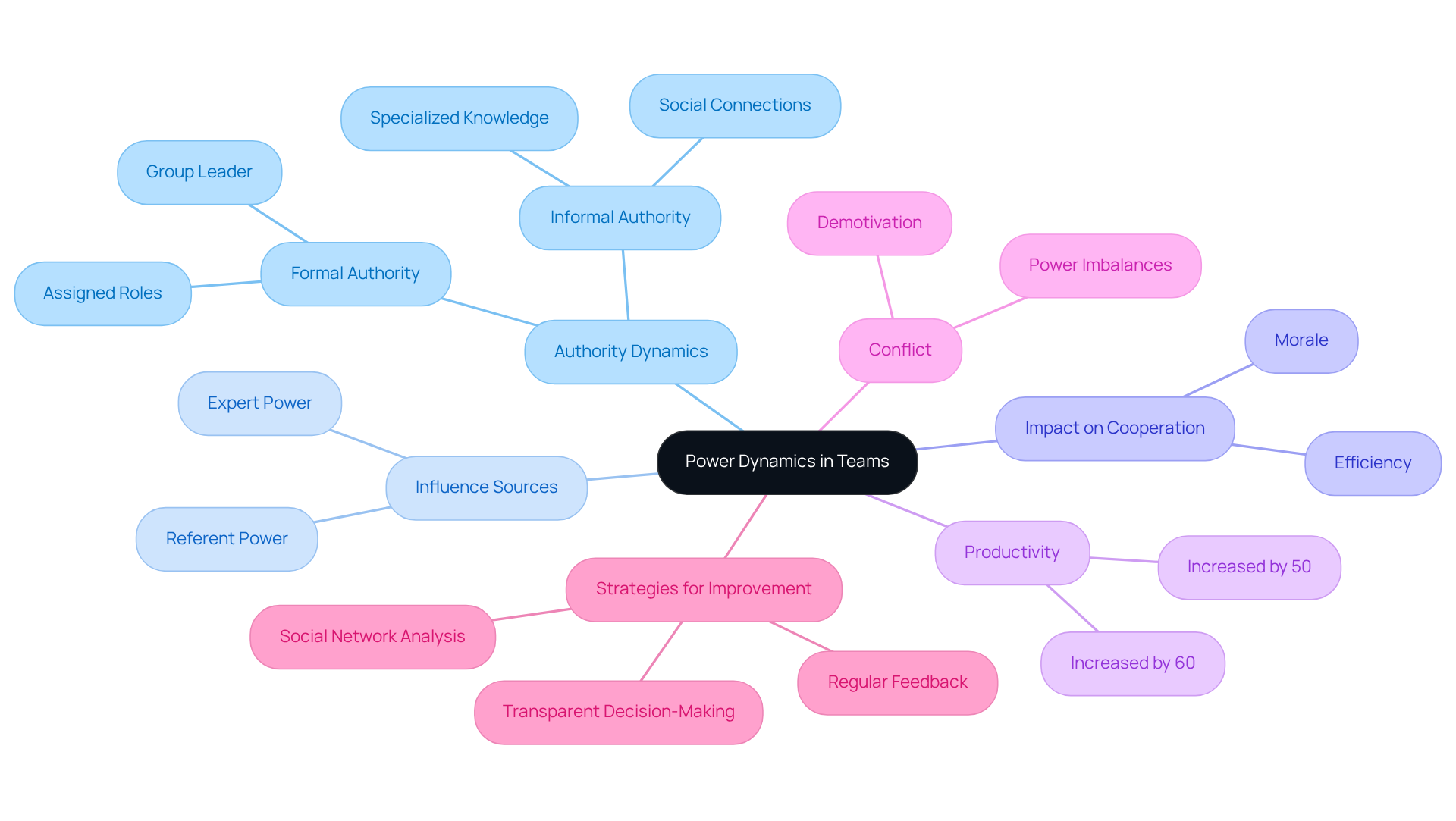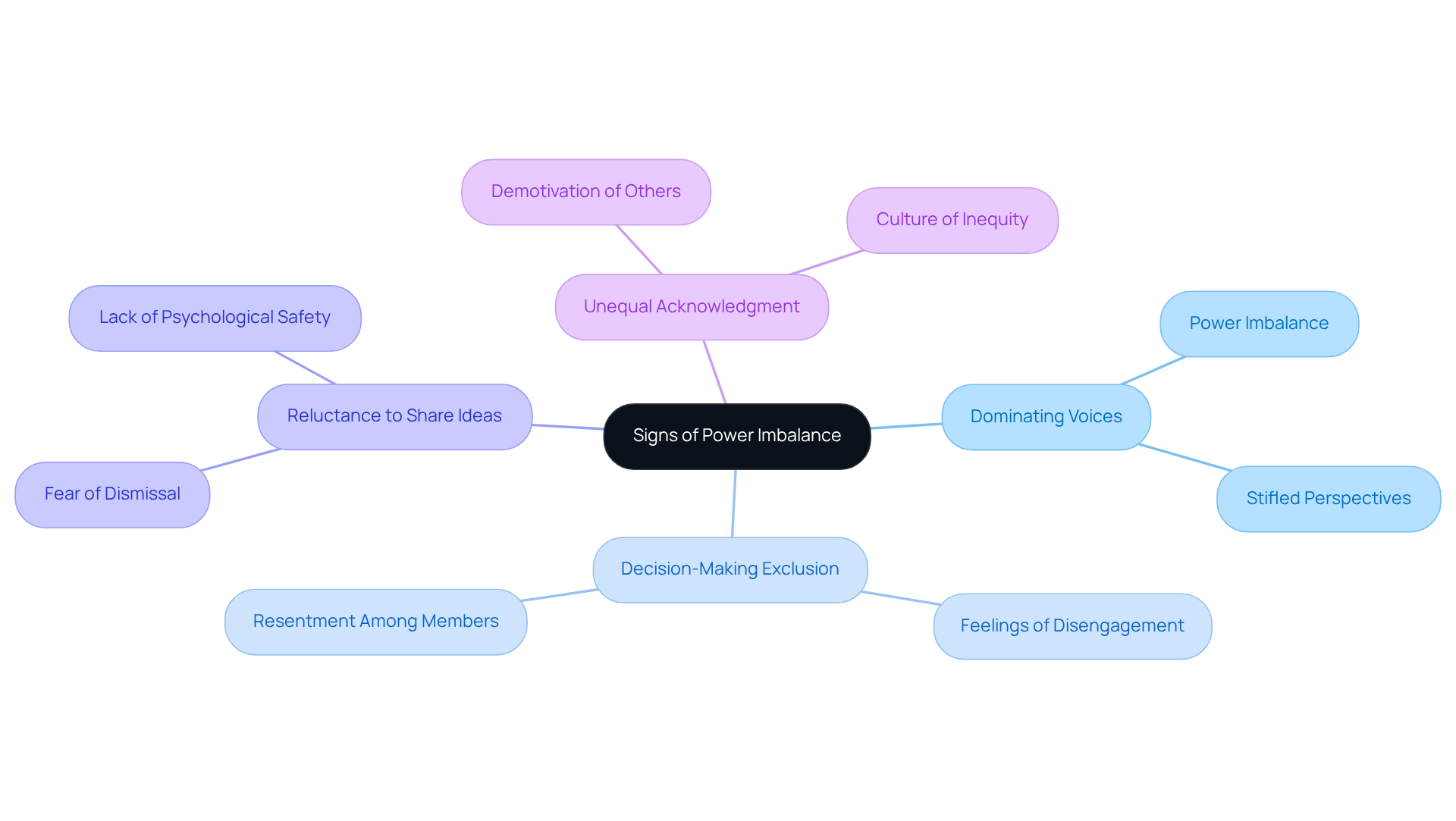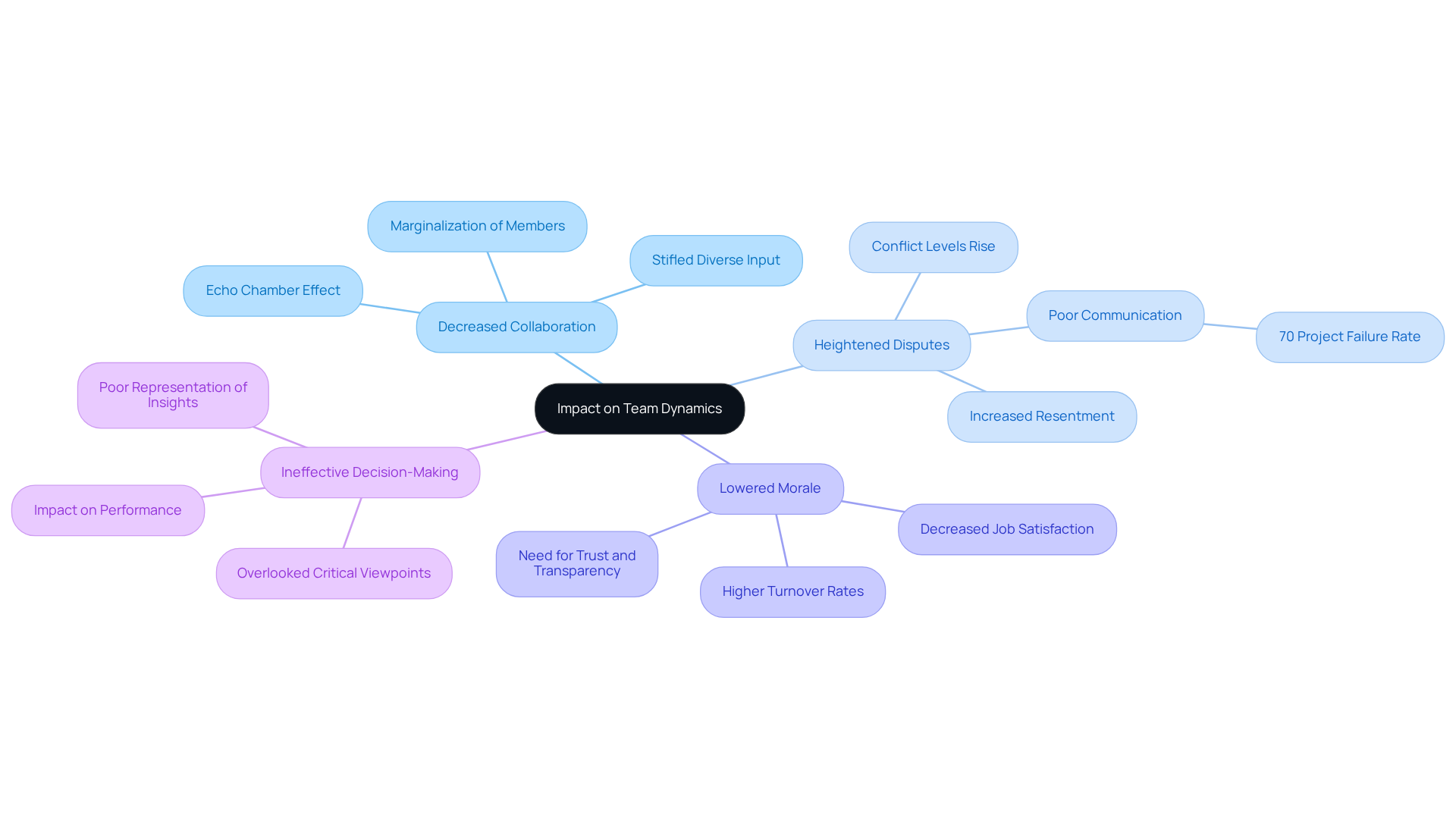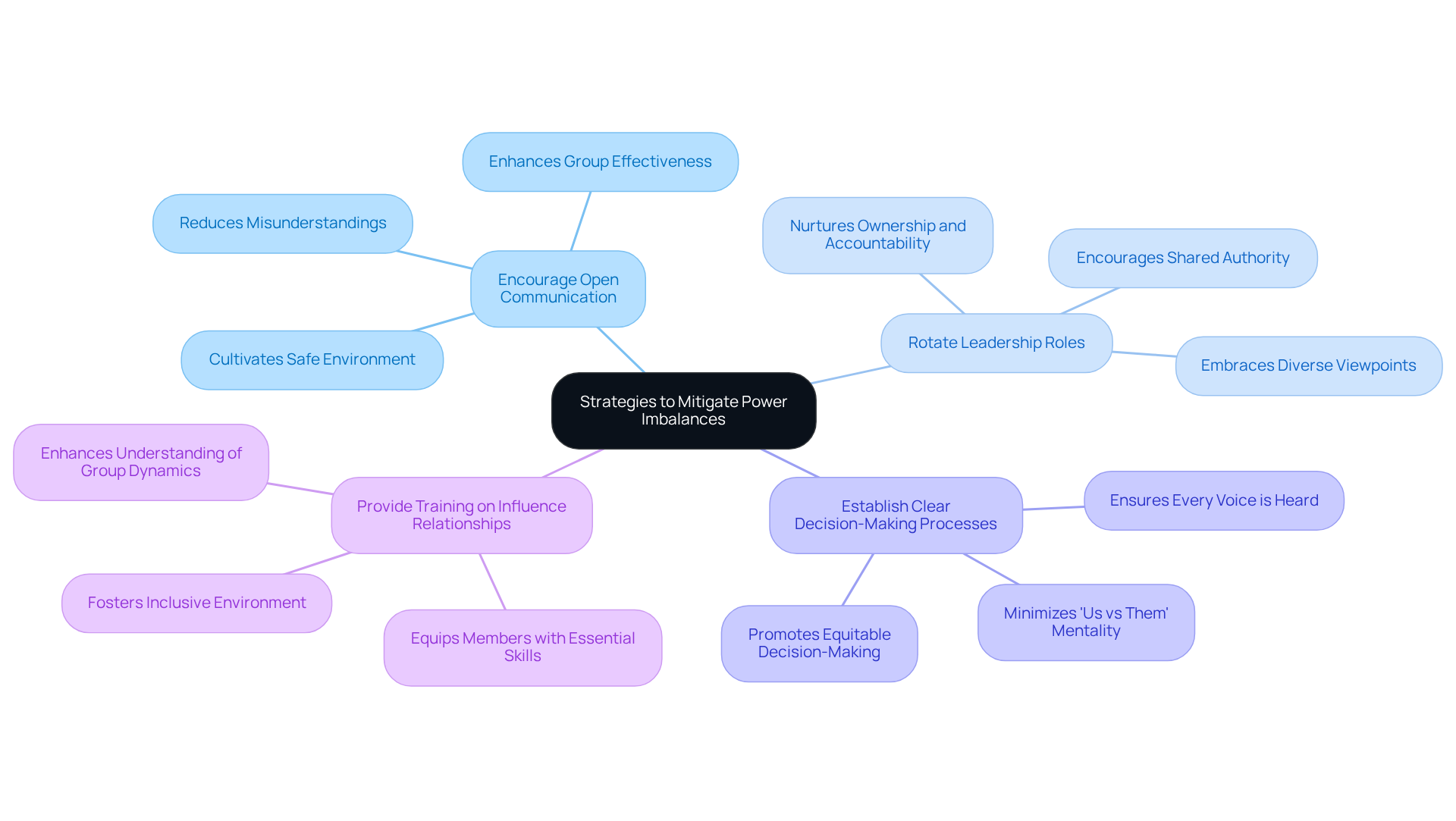
4 Steps to Address When a Power Imbalance Exists
Overview
This article centers on the steps we can take to address power imbalances within our teams. Recognizing and mitigating these imbalances is crucial for enhancing collaboration and productivity. Have you ever felt unheard or overlooked in a group setting? You're not alone.
By encouraging open communication, rotating leadership roles, and establishing transparent decision-making processes, we can create a more equitable environment. These strategies not only foster inclusivity but also improve overall team dynamics.
Together, let’s explore how these approaches can transform our collaborative efforts.
Introduction
Understanding the intricate web of power dynamics within teams is essential for fostering an environment of collaboration and productivity. As authority shifts among members based on roles and expertise, it’s important to recognize that these changes can lead to imbalances, potentially resulting in conflict, disengagement, and reduced effectiveness.
How can we identify these disparities together? What strategies can we implement to create a more equitable atmosphere? This article explores the steps necessary to address power imbalances, ensuring that every voice is heard and valued. By doing so, we can enhance group performance and morale, creating a supportive environment where everyone thrives.
Define Power Dynamics in Teams
Authority dynamics play a crucial role in how influence is shared among group members, impacting cooperation and efficiency. Have you ever noticed how different individuals in a group hold varying levels of influence? This difference often stems from their roles, expertise, and relationships with one another. For example, while a group leader may have formal authority, other members can wield significant influence through their specialized knowledge or social connections.
As Sarah Lee wisely notes, "Comprehending and maneuvering through influence dynamics within groups is essential for promoting a cooperative and efficient atmosphere." Research shows that groups that effectively balance authority with collaboration can be 50% more productive and 60% more innovative, according to a study by Harvard Business Review. Understanding how these layers of influence interact is vital for addressing any imbalances that might hinder group performance and morale.
When a power imbalance exists, it can lead to conflict, demotivation, and inefficiency, which ultimately affect group performance negatively. Leaders who grasp both formal and informal authority structures can foster an inclusive and respectful environment, enhancing group interactions and outcomes.
To visualize these dynamics, consider utilizing tools like social network analysis. This approach can help you implement strategies that promote transparency and collaboration. Together, we can create a more supportive atmosphere where everyone feels valued and empowered.

Identify Signs of Power Imbalance
Recognizing indicators of inequality within a team is essential for nurturing a healthy and productive work atmosphere. Have you ever noticed how some voices tend to dominate discussions? This can be a clear sign of a power imbalance when a power imbalance exists, where one or two individuals overshadow others. It’s important to remember that this dynamic can stifle diverse perspectives and hinder collaborative decision-making.
Another indicator to consider is decision-making exclusion. If specific participants are routinely left out of key decisions, it indicates that a situation arises when a power imbalance exists. This exclusion can lead to feelings of disengagement and resentment among group members. How might this impact the overall morale of your team?
Additionally, pay attention to individuals who hesitate to share their ideas or feedback. Often, this reluctance stems from a fear of dismissal or ridicule, indicating a lack of psychological safety within the group. We all want to feel safe and valued in our contributions.
Moreover, it reflects an imbalance in influence and visibility when a power imbalance exists and only a select few individuals receive acknowledgment for group successes. This can demotivate others and create a culture of inequity. It’s crucial to foster an environment where every contribution is recognized.
As Anne Fulton notes, "It’s time to move forward and democratize the talent marketplace to give employees more control and autonomy over their career paths and future opportunities." By acknowledging these signs, we can better evaluate our surroundings and promote a more balanced interaction. Let’s work together to improve collaboration and productivity in our teams.

Assess Impact on Team Dynamics
Power imbalances can significantly disrupt team dynamics in various ways, affecting not just productivity but also the emotional well-being of team members.
-
Decreased Collaboration: Have you ever felt sidelined in a group? When certain members feel marginalized, they often withdraw from collaborative efforts. This withdrawal stifles diverse input and hinders innovation. It can create an echo chamber where only dominant voices are heard, limiting the group's overall effectiveness.
-
Heightened Disputes: Imbalances can foster resentment and frustration among group participants. This often leads to conflicts that weaken group unity. In fact, studies suggest that groups facing inequality report increased conflict levels. Research shows that inadequate communication is the primary cause of project failure in 70% of instances, and this can intensify if not resolved quickly.
-
Lowered Morale: Consider how it feels to be undervalued. Team members who perceive themselves as ignored may suffer from decreased job satisfaction, contributing to higher turnover rates. Indira B., a leadership coach, emphasizes that cultivating trust and transparent communication is essential for tackling imbalances and preserving a positive group atmosphere.
-
Ineffective Decision-Making: Without diverse perspectives, decision-making can falter. Critical viewpoints may be overlooked, leading to choices that do not represent the group's collective insights. This ultimately impacts performance and results.
Understanding these effects highlights the importance of addressing authority relationships within groups. By fostering a more equitable environment, we can enhance collaboration, reduce conflict, and improve overall group morale. Let's work together to create a supportive atmosphere where everyone's voice is valued.

Implement Strategies to Mitigate Imbalances
To effectively mitigate power imbalances within teams, we can explore several nurturing strategies that promote fairness and collaboration:
-
Encourage Open Communication: It's essential to cultivate an environment where every team member feels safe to express their thoughts and concerns. Regular check-ins can facilitate this connection. Studies show that open communication significantly enhances group effectiveness and reduces misunderstandings. When we acknowledge that poor power distribution can stifle creativity and agility, it becomes clear that fostering open dialogue is vital, particularly when a power imbalance exists.
-
Rotate Leadership Roles: By allowing different individuals to assume leadership roles for various projects, we encourage shared authority and embrace diverse viewpoints. This practice not only empowers individuals but also nurtures a sense of ownership and accountability within the group.
-
Establish Clear Decision-Making Processes: Creating transparent decision-making processes ensures that every voice is heard and valued. This approach minimizes the risk of an 'us versus them' mentality, which can obstruct effective collaboration. Tania Luna reminds us that individuals often feel powerless and shy away from taking risks when a power imbalance exists, highlighting the importance of equitable decision-making.
-
Provide Training on Influence Relationships: Offering workshops or training sessions focused on understanding and managing influence relationships equips group members with essential skills. Such training helps individuals recognize their own influence and its impact on group dynamics, ultimately fostering a more inclusive environment. Dr. Paul Crampton emphasizes that grasping these dynamics is crucial for effective teamwork.
By embracing these strategies, we can work towards a more equitable distribution of authority, enhancing cooperation and overall efficiency. Real-world examples reveal that organizations prioritizing open communication and equitable power distribution experience improved morale and creativity, leading to better outcomes for everyone involved. For instance, the case study on 'A Shift From 'Power Over' To 'Power With'' illustrates how these strategies can transform team dynamics, reminding us that together, we can create a supportive and thriving environment.

Conclusion
Recognizing and addressing power imbalances within teams is essential for fostering a collaborative and productive work environment. By understanding the dynamics of authority and influence, we can create spaces where every voice is heard and valued. This approach not only enhances team performance but also uplifts morale.
Have you noticed dominant voices overshadowing others? Or perhaps some team members hesitate to share their ideas? These signs are critical in identifying power imbalances that can hinder collaboration and escalate disputes. The impacts are real—lowered morale and diminished group dynamics can significantly affect our collective success.
To cultivate a more equitable environment, we can implement strategies that encourage open communication, rotate leadership roles, establish clear decision-making processes, and provide training on influence relationships. By embracing these practices, we can improve our dynamics and foster a culture of inclusivity and respect. Remember, addressing power imbalances is not solely a managerial responsibility; it’s a collective effort that can lead to enhanced creativity, innovation, and ultimately, a more successful team.
Let’s take these steps together, ensuring that everyone feels valued and empowered in our team.
Frequently Asked Questions
What are power dynamics in teams?
Power dynamics in teams refer to the varying levels of influence among group members, which are affected by their roles, expertise, and relationships. These dynamics play a crucial role in how authority and influence are shared within the group.
How do authority dynamics impact group performance?
Authority dynamics impact group performance by affecting cooperation and efficiency. Groups that effectively balance authority with collaboration can be significantly more productive and innovative.
What are the consequences of power imbalances in teams?
Power imbalances can lead to conflict, demotivation, and inefficiency, negatively affecting group performance and morale.
How can leaders address power dynamics in their teams?
Leaders can address power dynamics by understanding both formal and informal authority structures, fostering an inclusive and respectful environment to enhance group interactions and outcomes.
What tools can help visualize power dynamics in teams?
Tools like social network analysis can help visualize power dynamics, allowing teams to implement strategies that promote transparency and collaboration.
What is the importance of understanding influence dynamics in groups?
Understanding influence dynamics is essential for promoting a cooperative and efficient atmosphere, as it helps address any imbalances that might hinder group performance.


